
The United States Naval Research Laboratory (NRL) is the corporate research laboratory for the United States Navy and the United States Marine Corps. It was founded in 1923 and conducts basic scientific research, applied research, technological development and prototyping. The laboratory's specialties include plasma physics, space physics, materials science, and tactical electronic warfare. NRL is one of the first US government scientific R&D laboratories, having opened in 1923 at the instigation of Thomas Edison, and is currently under the Office of Naval Research.
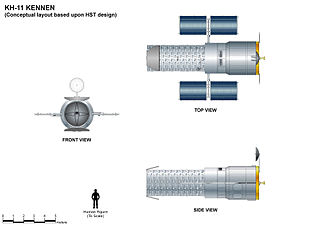
The KH-11 KENNEN is a type of reconnaissance satellite first launched by the American National Reconnaissance Office (NRO) in December 1976. Manufactured by Lockheed in Sunnyvale, California, the KH-11 was the first American spy satellite to use electro-optical digital imaging, and so offer real-time optical observations.

The SAMOS or SAMOS-E program was a relatively short-lived series of reconnaissance satellites for the United States in the early 1960s, also used as a cover for the initial development of the KH-7 GAMBIT system. Reconnaissance was performed with film cameras and television surveillance from polar low Earth orbits with film canister returns and transmittals over the United States. SAMOS was first launched in 1960 from Vandenberg Air Force Base.
Lockheed Martin Space is one of the four major business divisions of Lockheed Martin. It has its headquarters in Littleton, Colorado, with additional sites in Valley Forge, Pennsylvania; Sunnyvale, California; Santa Cruz, California; Huntsville, Alabama; and elsewhere in the United States and United Kingdom. The division currently employs about 16,000 people, and its most notable products are commercial and military satellites, space probes, missile defense systems, NASA's Orion spacecraft, and the Space Shuttle external tank.

The United States Space Surveillance Network (SSN) detects, tracks, catalogs and identifies artificial objects orbiting Earth, e.g. active/inactive satellites, spent rocket bodies, or fragmentation debris. The system is the responsibility of United States Space Command and operated by the United States Space Force.
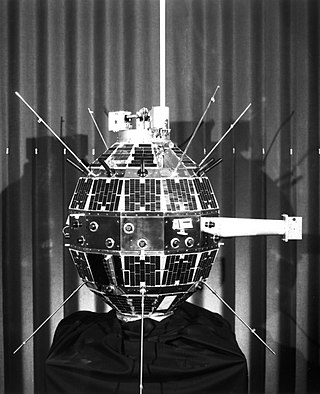
POPPY is the code name given to a series of U.S. intelligence satellites operated by the National Reconnaissance Office. The POPPY satellites recorded electronic signals intelligence (ELINT) data, targeting radar installations in the Soviet Union and Soviet naval ships at sea.
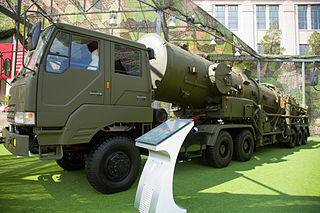
The Dong-Feng 21 (DF-21; NATO reporting name CSS-5 - Dong-Feng is a two-stage, solid-fuel rocket, single-warhead medium-range ballistic missile in the Dong Feng series developed by China Changfeng Mechanics and Electronics Technology Academy. Development started in the late 1960s and was completed around 1985–86, but it was not deployed until 1991. It was developed from the submarine-launched JL-1 missile, and is China's first solid-fuel land-based missile. The U.S. Department of Defense in 2008 estimated that China had 60-80 missiles and 60 launchers; approximately 10-11 missiles can be built annually.

Space Systems Command (SSC) is the United States Space Force's space development, acquisition, launch, and logistics field command. It is headquartered at Los Angeles Air Force Base, California and manages the United States' space launch ranges.
Signals intelligence by alliances, nations and industries comprises signals intelligence (SIGINT) gathering activities by national and non-national entities; these entities are commonly responsible for communications security (COMSEC) as well.
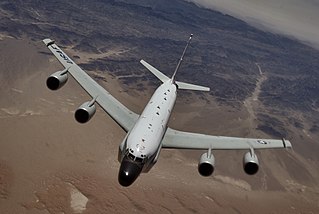
Signals intelligence operational platforms are employed by nations to collect signals intelligence, which is intelligence-gathering by interception of signals, whether between people or between machines, or mixtures of the two. As sensitive information is often encrypted, signals intelligence often involves the use of cryptanalysis. However, traffic analysis—the study of who is signalling whom and in what quantity—can often produce valuable information, even when the messages themselves cannot be decrypted.
Before the development of radar and other electronics techniques, signals intelligence (SIGINT) and communications intelligence (COMINT) were essentially synonymous. Sir Francis Walsingham ran a postal interception bureau with some cryptanalytic capability during the reign of Elizabeth I, but the technology was only slightly less advanced than men with shotguns, during World War I, who jammed pigeon post communications and intercepted the messages carried.
Integrated Overhead SIGINT Architecture, or IOSA, incorrectly reported to be codenamed Intruder, was a spy satellite system to be operated by the United States National Reconnaissance Office, which would have replaced the Mentor and Mercury systems. The satellites were reported to have been under development in 1995. The Intruder system was designed to combine the electronic signals intelligence (ELINT) and communications intelligence (COMINT) roles of signals Intelligence (SIGINT) spacecraft, which had previously been performed by different satellites, the Rhyolite and Vortex series respectively.

Yaogan is the cover name used by the People's Republic of China to refer to its military reconnaissance satellites. Yaogan satellites are largely known to primarily support the People's Liberation Army's Strategic Support Force (PLASSF), formerly the Aerospace Reconnaissance Bureau of the Second Department of the General Staff. Yaogan satellites are the successor program to the Fanhui Shi Weixing (FSW) recoverable reconnaissance satellite program but, unlike its predecessor, includes a variety of classes utilizing various means of remote sensing such as optical reconnaissance, synthetic-aperture radar (SAR), and electronic intelligence (ELINT) for maritime surveillance. Yaogan satellites have been launched from the Taiyuan Satellite Launch Center (TSLC) in Shanxi province, the Jiuquan Satellite Launch Center (JSLC) in Inner Mongolia Autonomous Region, and the Xichang Satellite Launch Center (XSLC) in Sichuan province.
SLDCOM is a satellite communications system operated by the U.S. National Reconnaissance Office and used by the United States Armed Forces. The space-based assets of the system were flown as part of the Satellite Launch Dispenser (SLD) hardware on several Titan IV rocket launches which also launched Naval Ocean Surveillance System (NOSS) satellites. The SLDCOM system provides bent pipe UHF communications.
USA-229, known before launch as NRO Launch 34 (NROL-34), is a pair of American signals intelligence satellites which were launched in 2011. They are operated by the United States National Reconnaissance Office.
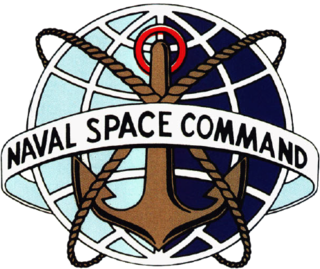
The Naval Space Command (NSC) was a military command of the United States Navy and former component command of United States Space Command. It was headquartered at Dahlgren, Virginia, and began operations on 1 October 1983. Naval Space Command used space capabilities to support naval forces through the operation of reconnaissance and communications satellites, as well as representing the Navy's space interests, both within the Navy and within U.S. Space Command.
SOLRAD 7A was the seventh solar X-Ray monitoring satellite in the SOLRAD series, and the fourth to successfully orbit the Earth. It was boosted into orbit along with four other military satellites atop a Thor Augmented Delta-Agena D rocket on January 11, 1964. Data returned by SOLRAD 7A dramatically revised scientific models of the solar corona.
SOLRAD 6 was the sixth solar X-ray monitoring satellite in the United States Navy's SOLRAD series, the third in the series to successfully orbit. It was launched along with POPPY 2, an ELINT surveillance package, as well as three other satellites, boosted into orbit via a Thor Augmented Delta-Agena D rocket on June 15, 1963.

The Hibiki-class ocean surveillance ship is a class of surveillance ships operated by the Japan Maritime Self-Defense Force. The ships have a small-waterplane-area twin hull (SWATH) design.
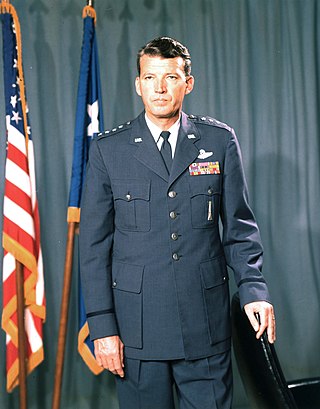
While the United States Space Force gained its independence on 20 December 2019, the history of the United States Space Force can be traced back to the beginnings of the military space program following the conclusion of the Second World War in 1945. Early military space development was begun within the United States Army Air Forces by General Henry H. Arnold, who identified space as a crucial military arena decades before the first spaceflight. Gaining its independence from the Army on 18 September 1947, the United States Air Force began development of military space and ballistic missile programs, while also competing with the United States Army and United States Navy for the space mission.














